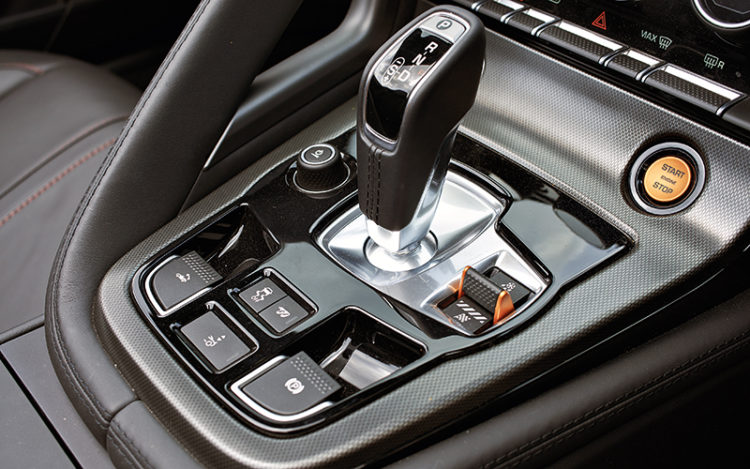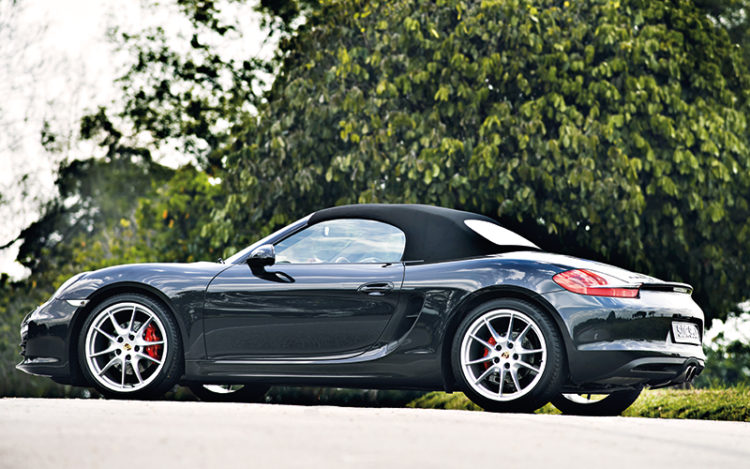 Yes, its 3.4-litre flat-6 has the engine type’s trademark off-beat thrum, but even when you’ve shelled out for the optional sports exhaust, which offers a fruitier note and obligatory pops on the overrun, the Boxster never comes close to the raunchy wail of the F-Type.
Yes, its 3.4-litre flat-6 has the engine type’s trademark off-beat thrum, but even when you’ve shelled out for the optional sports exhaust, which offers a fruitier note and obligatory pops on the overrun, the Boxster never comes close to the raunchy wail of the F-Type.
Plus, the Boxster’s naturally aspirated powerplant produces “only” 315bhp and 360Nm, giving it a 65bhp/100Nm deficit on the F-Type. The Boxster’s lack of forced-induction also gives its power delivery a more linear nature, versus the mailed-fist thump of the F-Type.
 The opposed nature of their power delivery also neatly sums up each car’s distinct personality. Where the Jaguar loves being grabbed by the scruff of the neck and hurled into corners, the Porsche prefers a smoother approach.
The opposed nature of their power delivery also neatly sums up each car’s distinct personality. Where the Jaguar loves being grabbed by the scruff of the neck and hurled into corners, the Porsche prefers a smoother approach.
Of course, you could drive the Jaguar in a more measured fashion, but then you’d feel every bit of its high kerb weight of 1614kg (very portly despite the aluminium chassis). The F-Type doesn’t so much dart into corners as it heaves into them.
![]() Conversely, thrashing the Porsche to within an inch of its life – while you could very well do so – doesn’t exactly feel particularly rewarding, in that although it is devastatingly competent, the Boxster doesn’t quite have the same zest that the orange Jaguar does.
Conversely, thrashing the Porsche to within an inch of its life – while you could very well do so – doesn’t exactly feel particularly rewarding, in that although it is devastatingly competent, the Boxster doesn’t quite have the same zest that the orange Jaguar does.
Part of why the Boxster can seem to lack involvement is how its steering is now an electrically assisted affair. Purists screamed blue murder when they found out, especially since the Boxster’s old hydraulic power steering setup was famed for its gorgeous, granular feel.
![]() Don’t get us wrong – the Boxster’s steering is right up there with the best of them, what with its levels of to-the-millimetre accuracy and quickness. However, against the brawny feel and liveliness of the F-Type’s hydraulic setup, the Boxster can seem a little sterile.
Don’t get us wrong – the Boxster’s steering is right up there with the best of them, what with its levels of to-the-millimetre accuracy and quickness. However, against the brawny feel and liveliness of the F-Type’s hydraulic setup, the Boxster can seem a little sterile.
But when it comes to the crunch, that is, choosing which car to plonk your hard-earned dollars on we’re leaning towards the Boxster.

Carbon-ceramic brakes can be had with Porsche Boxster S’ 20-inch wheels.
Yes, in the real world the Boxster may not be all that much cheaper, due to how Porsche will want to charge you extra for just about everything. Want “proper” shift paddles, where you pull on the left one for downshifts and the right one for upshifts, instead of the wonky thumb-shifters on our test unit? That costs extra, too. Hanker for our test car’s extended red leather trim? Needless to say, it’ll cost you a pretty penny.
A quick whirl on Porsche’s online configurator will reveal how easy it is to spend almost $500,000 on a Boxster. This expansive, expensive options list might go some way to explaining Porsche’s current good fortunes, but we digress.

Jaguar alloys’ carbon fibre is cosmetic, not structural.
It lacks the all-out mania of the F-Type, but we find its neutral nature less wearing and its relatively low kerb weight of 1350kg makes it feel more agile against the rather porky Jaguar.
That also gives the Boxster a similar power-to-weight ratio to the Jaguar, and crucially, a 0-100km/h timing just 0.1 of a second off the F-Type’s.
Then, there’s how the Jaguar’s riotous nature can feel quite contrived. Instead of natural, we get the feeling that someone at Jaguar polled a bunch of teenagers and asked them what they’d like to see in a sports car. As a result, it’s almost impossible to drive the F-Type in a “normal” fashion, unlike the Boxster.
The Boxster is quite happy to sit through the monotony of city driving (although whether the same can be said for you is a different story) and only unsheath its claws when the roads turn twisty.
 In short, the Boxster is an easier car to live with day-to-day in the real world. That is, a world where there are speed limits and how you’re being constantly observed by the ever-watchful, all-seeing eye of a traffic cop’s speed gun.
In short, the Boxster is an easier car to live with day-to-day in the real world. That is, a world where there are speed limits and how you’re being constantly observed by the ever-watchful, all-seeing eye of a traffic cop’s speed gun.
And a world where, on some days, you just want a quiet drive to work, and not have to be constantly goaded by your car into performing unspeakable acts of tyre-shredding hooliganism.
It seems the Boxster will keep its crown for now, but there’s no denying there were a few moments back there when Jaguar’s orange sensation nearly breached Castle Porsche’s once-impregnable stronghold.

Porsche Boxster S 3.4 (A)
ENGINE 3436cc, 24-valves, flat-6
MAX POWER 315bhp at 6700rpm
MAX TORQUE 360Nm at 4500-5800rpm
GEARBOX 7-speed dual-clutch with manual select
0-100KM/H 5 seconds
TOP SPEED 277km/h
CONSUMPTION 12.5km/L
Jaguar F-Type S 3.0 (A)
ENGINE 2995cc, 24-valves, V6, supercharged
MAX POWER 380bhp at 6500rpm
MAX TORQUE 460Nm at 3500-5000rpm
GEARBOX 8-speed automatic with manual select
0-100KM/H 4.9 seconds (estimated)
TOP SPEED 275km/h
CONSUMPTION 10.9km/L (combined)
Check out our Porsche 718 Boxster review here
Is the Jaguar F-Type 2.0 still a sporty drive? Find out here












